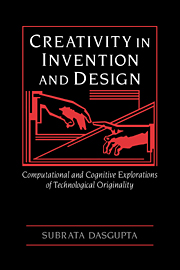Book contents
- Frontmatter
- Contents
- Preface
- Acknowledgments
- Part I Creativity in invention and design: issues and ingredients
- Part II The invention of microprogramming: a cognitive explanation
- 4 Prolegomenon
- 5 The genesis of an idea: creating the initial sketch
- 6 The evolution of an idea: from initial sketch to mature form
- Part III Reflections on the nature of inventing
- Appendix
- References
- Index
4 - Prolegomenon
Published online by Cambridge University Press: 23 December 2009
- Frontmatter
- Contents
- Preface
- Acknowledgments
- Part I Creativity in invention and design: issues and ingredients
- Part II The invention of microprogramming: a cognitive explanation
- 4 Prolegomenon
- 5 The genesis of an idea: creating the initial sketch
- 6 The evolution of an idea: from initial sketch to mature form
- Part III Reflections on the nature of inventing
- Appendix
- References
- Index
Summary
The main ingredients have now been assembled. We have, first, a computational theory of scientific creativity, CTSC. Its central thesis is that a cognitive act resulting in a scientific product – a solution to a scientific problem – deemed original by the originator or by the relevant scientific community can be specified as, or be explained in the form of, a knowledge-level process.
Second, we have a detailed account of the circumstances attending a particular episode from the arena of computer science: the invention of microprogramming. Since computer science is a science of the artificial, one can regard this invention as signifying the creation of a technological idea, the invention of a new artifactual form that satisfies certain functions or, more prosaically, as an instance of highly original design. In the artificial sciences, these views are virtually indistinguishable.
This historical account is as detailed as the documented evidence will allow. And viewed as a historical explanation, it would appear to be satisfactory. That is, to the question What were the circumstances attending Wilkes's invention of microprogramming? the narrative presented in Chapter 3 would constitute an explanation of the sort historians of science ordinarily produce. It identifies the state of affairs that existed regarding computers and computing circa 1950. It then presents the particular problem that exercised Wilkes (i.e., that of regularity and order in the design of the control unit) and describes, in terms of the known state of affairs (specifically with regard to the EDSAC), how or why the problem arose. The narrative then points out that Wilkes was led to the idea of the diode matrix in the EDSAC order interpreter.
- Type
- Chapter
- Information
- Creativity in Invention and Design , pp. 91 - 102Publisher: Cambridge University PressPrint publication year: 1994



